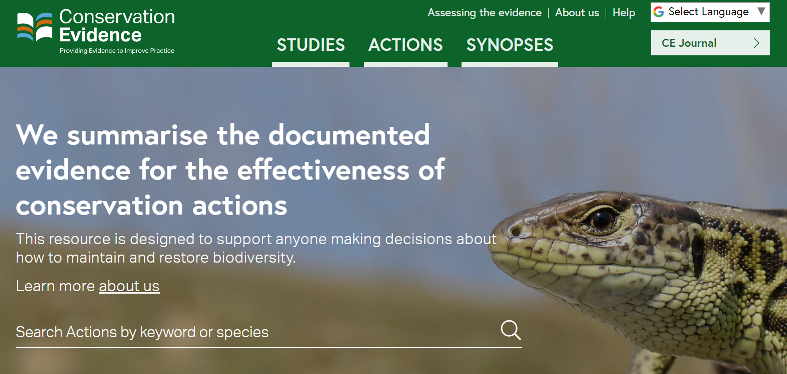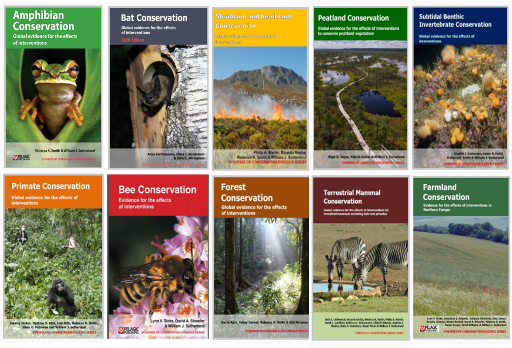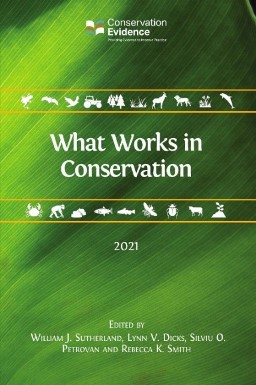What Works in Conservation?
This post is greater than 6 months old - links may be broken or out of date. Proceed with caution!

By Kate Willott, Research Assistant
Perhaps you work in conservation, or want to. If so, it is probably because you care about wildlife and wild places and want to protect them. So how can we best protect the nature that we care about? One important aspect is making sure that each conservation action we take is the most effective one possible.
Finding out which conservation actions work best can be difficult. If you wanted to know whether to put up artificial nesting sites for owls and which type to use, what time of year to mow your meadow, or how to help mammals safely cross the road, how would you go about it? You could ask lots of people, or try to read scientific papers; but people’s anecdotes can be unreliable, and many academic papers are hidden behind paywalls and tough to read. Alternatively, you could look at the Conservation Evidence database.

What is the Conservation Evidence project?
This free, authoritative, information resource is designed to support decisions about how to maintain and restore global biodiversity. It does this by collecting the scientific evidence on how well different conservation actions or solutions work, and providing summaries of evidence about the effects of conservation actions (such as methods of habitat or species management) from scientific papers and documented literature in plain English.
Why use Conservation Evidence?
Not using the documented evidence in decisions has been shown to lead to detrimental actions being undertaken that waste time, money and other resources, all of which are scarce in conservation. In order to meet many critical conservation and biodiversity targets we need to avoid this. Conservation Evidence should be used, alongside other important information, to further help you make the most informed decision possible.
What information is available on the Conservation Evidence website?
Evidence of the effectiveness of actions is collated into synopses based upon species groups such as terrestrial mammal conservation, habitats such as peatland conservation, or particular conservation issues such as control of invasive species.

While many topics have already been covered (see the synopses currently available here), more are coming soon (see here). Our aim is to summarise evidence for all species groups and habitats.
Conservation Evidence’s flagship publication, What Works in Conservation, provides a freely-available, comprehensive overview of a panel of experts’ assessment of evidence for the effectiveness (or not) of the management actions collated within the Conservation Evidence synopses (for more details and to download, see here). This allows users to see at a glance whether an action is likely to be beneficial or not; of course, it’s always important to check the details!

Access to this resource helps inform the work of decision-makers, conservation managers, practitioners and policy-makers to incorporate evidence into their management decisions and to conserve threatened species.
How can Conservation Evidence be used to make decisions?
You could, for example, try to find evidence on different ways to prevent bat fatalities caused by wind turbines. You could click on the bat synopsis icon on Conservation Evidence and then enter ‘turbine’ in the keyword search box under ‘Refine’ on the left hand side, giving you all of the possible actions. You could click on a few ‘actions’ to see how effective they were from the studies summarised. For example, based on a reasonable number of studies, two similar actions have been classified by experts as being ‘beneficial’ resulting in fewer bat fatalities than at conventionally operated turbines: i) increasing the wind speed at which turbines become operational (‘cut-in speed’); and ii) preventing turbine blades from turning at all low wind speeds ('feathering'). So these options could be worth investigating further for your project.
Based on a smaller number of studies, two of the actions have been classified by experts as ‘unknown effectiveness (limited evidence)’: i) four studies tested broadcasting ultrasonic sounds at the frequency range which bats use for echolocation, to deter bats from turbines, but the results were mixed in three studies and insignificant in one study; and ii) only one study tested the application of a textured coating to turbines, to prevent bats misidentifying them as water or clear flight paths, but it found no effect. Further studies would be required in order to determine the effectiveness of these two actions with greater certainty.

When deciding which actions you might take, you should look at how similar the species studied are to your own circumstances. A study on forest adapted bats may not be applicable in a city, and tropical studies might not be relevant in the temperate zones, for example.
You should also look at how well conducted the studies were. A study with a very small sample size might not be reliable, or a study might not have an appropriate ‘control’ where no action took place. You must use your professional judgement to assess the quality and relevance of each study, and how much weight to give it in your decision making.
Hopefully this gives you an idea for how you might use Conservation Evidence to choose which action might be the most effective, and how different ways of implementing those actions affect their success (or otherwise).
What else does Conservation Evidence do?
The team at Conservation Evidence are not only working on collating the documented evidence, but are also looking at ways to make the evidence easier to use, these include through: the Evidence Champions programme, Decision support tools, Metadataset, and Evidence-based guidance. See our website for more information.
Conservation Evidence can be used along with other forms of evidence and professional judgement to make the best informed and hopefully most effective decisions on how to conserve our natural world.
You, your colleagues and/or your organisation can also help to fill gaps in the evidence base by publishing new evidence in our online, open access, peer-reviewed Conservation Evidence Journal. The journal publishes results from research and projects investigating the effectiveness of conservation actions.
Updated information October 2023:
Conservation Evidence now provides additional valuable resources to help overcome barriers to evidence use and ensure more effective decision-making in conservation practice. For example:
- The Evidence Toolkit - principles, tools, and resources co-designed with the conservation community.
- An open access book - Transforming Conservation: A Practical Guide to Evidence and Decision Making.
We also have a Blog which provides news, updates and insights related to evidence-based conservation from the Conservation Evidence team as well as our partner organisations and others in the conservation community.
For a summary of our work see About Conservation Evidence.
More from Conservation Evidence